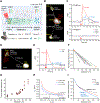Probing Neuropeptide Volume Transmission In Vivo by Simultaneous Near-Infrared Light-Triggered Release and Optical Sensing
- PMID: 35723610
- PMCID: PMC9388559
- DOI: 10.1002/anie.202206122
Probing Neuropeptide Volume Transmission In Vivo by Simultaneous Near-Infrared Light-Triggered Release and Optical Sensing
Abstract
Neuropeptides are abundant signaling molecules in the central nervous system. Yet remarkably little is known about their spatiotemporal spread and biological activity. Here, we developed an integrated optical approach using Plasmonic nAnovesicles and cell-based neurotransmitter fluorescent engineered reporter (CNiFER), or PACE, to probe neuropeptide signaling in the mouse neocortex. Small volumes (fL to pL) of exogenously supplied somatostatin-14 (SST) can be rapidly released under near-infrared light stimulation from nanovesicles implanted in the brain and detected by SST2 CNiFERs with nM sensitivity. Our measurements reveal reduced but synchronized SST transmission within 130 μm, and markedly smaller and delayed transmission at longer distances. These measurements enabled a quantitative estimation of the SST loss rate due to peptide degradation and binding. PACE offers a new tool for determining the spatiotemporal scales of neuropeptide volume transmission and signaling in the brain.
Keywords: Biosensors; Brain; Neuropeptide Release; Neuropeptide Transmission; Plasmonic Nanovesicles.
© 2022 Wiley-VCH GmbH.
Conflict of interest statement
Conflict of interest
The authors declare no conflict of interest.
Figures




Similar articles
-
Understanding Neuropeptide Transmission in the Brain by Optical Uncaging and Release.ACS Chem Neurosci. 2023 Feb 15;14(4):516-523. doi: 10.1021/acschemneuro.2c00684. Epub 2023 Jan 31. ACS Chem Neurosci. 2023. PMID: 36719384 Free PMC article. Review.
-
Construction of Cell-based Neurotransmitter Fluorescent Engineered Reporters (CNiFERs) for Optical Detection of Neurotransmitters In Vivo.J Vis Exp. 2016 May 12;(111):53290. doi: 10.3791/53290. J Vis Exp. 2016. PMID: 27214050 Free PMC article.
-
Selective roles for the PC2 processing enzyme in the regulation of peptide neurotransmitter levels in brain and peripheral neuroendocrine tissues of PC2 deficient mice.Neuropeptides. 2003 Jun;37(3):140-8. doi: 10.1016/s0143-4179(03)00027-1. Neuropeptides. 2003. PMID: 12860111
-
Central somatostatin signaling and regulation of food intake.Ann N Y Acad Sci. 2019 Nov;1455(1):98-104. doi: 10.1111/nyas.14178. Epub 2019 Jun 25. Ann N Y Acad Sci. 2019. PMID: 31237362 Free PMC article. Review.
-
Neuropeptides and neuropeptide receptors: drug targets, and peptide and non-peptide ligands: a tribute to Prof. Dieter Seebach.Chem Biodivers. 2012 Nov;9(11):2367-87. doi: 10.1002/cbdv.201200288. Chem Biodivers. 2012. PMID: 23161624 Review.
Cited by
-
CGRP physiology, pharmacology, and therapeutic targets: migraine and beyond.Physiol Rev. 2023 Apr 1;103(2):1565-1644. doi: 10.1152/physrev.00059.2021. Epub 2022 Dec 1. Physiol Rev. 2023. PMID: 36454715 Free PMC article. Review.
-
Current Status and Future Strategies for Advancing Functional Circuit Mapping In Vivo.J Neurosci. 2023 Nov 8;43(45):7587-7598. doi: 10.1523/JNEUROSCI.1391-23.2023. J Neurosci. 2023. PMID: 37940594 Free PMC article.
-
Mapping and decoding neuropeptide signaling networks in nervous system function.Curr Opin Neurobiol. 2025 Jun;92:103027. doi: 10.1016/j.conb.2025.103027. Epub 2025 Apr 21. Curr Opin Neurobiol. 2025. PMID: 40262384 Free PMC article. Review.
-
A Biomimetic C-Terminal Extension Strategy for Photocaging Amidated Neuropeptides.J Am Chem Soc. 2023 Sep 13;145(36):19611-19621. doi: 10.1021/jacs.3c03913. Epub 2023 Aug 31. J Am Chem Soc. 2023. PMID: 37649440 Free PMC article.
-
Hypothermal opto-thermophoretic tweezers.Nat Commun. 2023 Aug 23;14(1):5133. doi: 10.1038/s41467-023-40865-y. Nat Commun. 2023. PMID: 37612299 Free PMC article.
References
-
- Lacin E, Muller A, Fernando M, Kleinfeld D, Slesinger PA, J. Vis. Exp 2016, e53290; - PMC - PubMed
- Muller A, Joseph V, Slesinger PA, Kleinfeld D, Nat. Methods 2014, 11, 1245–1252; - PMC - PubMed
- Foo C, Lozada A, Aljadeff J, Li Y, Wang JW, Slesinger PA, Kleinfeld D, Curr. Biol 2021, 31, 4111–4119. - PMC - PubMed
Publication types
MeSH terms
Substances
Grants and funding
LinkOut - more resources
Full Text Sources

